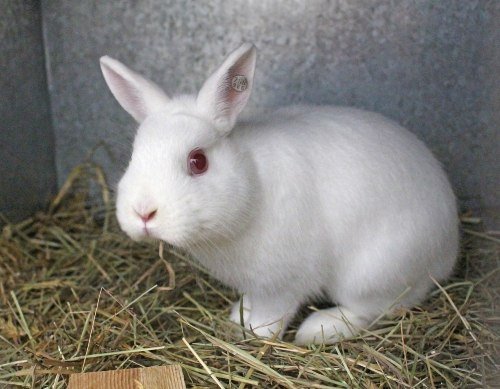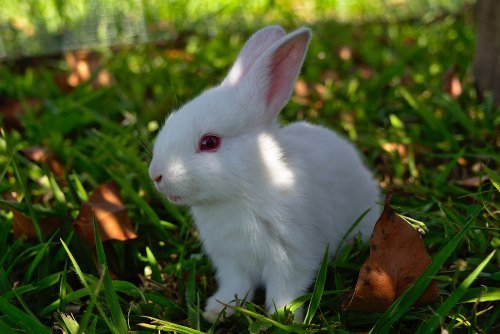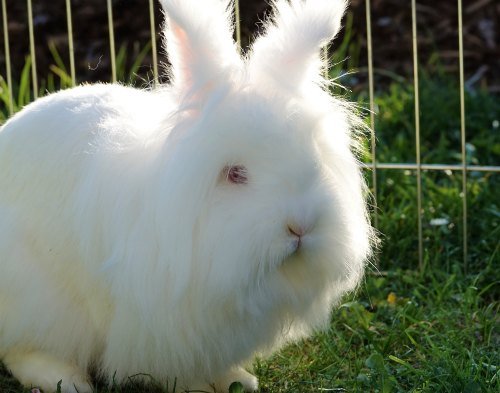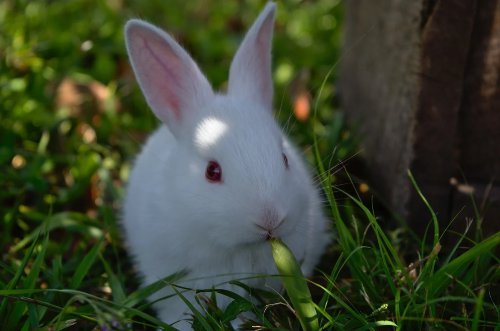Last Updated on June 12, 2023 by Emma Reynolds
Has your rabbit been born with red eyes and white fur? Have you been told that the red eyed bunny is an albino rabbit? Well, if you read on, we are going to tell you absolutely everything that you need to know about these white rabbits with red eyes.

What Does an Albino Rabbit Look Like?
An albino rabbit will always have two characteristics:
- Red eyes
- White fur
Only albino rabbits will ever have white fur (more on that in a short while), and only albino rabbits will be born with red eyes. If the rabbit doesn’t have both characteristics, then it is not going to be an albino rabbit.
Other than this, the rabbit’s look will be dependent on the breed. Remember; an albino rabbit is not an actual breed of rabbit. Nearly every rabbit breed could actually end up being an albino bunny.
Although, due to the way that albinism works, there are some breeds that are more likely to breed than others.
What Causes an Albino Rabbit?
Albinism in rabbits is due to a genetic mutation. Without going into the science of how it all works, all you really need to know is that a rabbit with albinism has a ‘flaw’ in the genes that tell the body to produce a color pigment known as tyrosinase.

This tyrosinase is an enzyme that causes melanin which, in turn, helps to color the fur of the rabbit. It is also the same enzyme that gives every animal (including humans!) their skin or fur color.
Rabbits are specially bred for this genetic mutation. Almost every rabbit with this mutation will create albino offspring, There are breeders that specially work on creating albino rabbits of several different breeds.
As we said before; it is far easier with some breeds to create white rabbits with red eyes or albino rabbits. There are some breeds that may never be available in albino, simply because the gene mutation has yet to be isolated.
As we also said before; the only way that you are going to be getting a white fur rabbit with red eyes is if it is an albino rabbit. There are no breeds of rabbit that will naturally be white.
This is impossible. They need a little bit of coloring in their fur.
White Rabbit With Red Eyes – Is it Dangerous?
Nope. Not in the slightest. There are only two real difficulties that you will face if you have an albino rabbit.
Although, this probably isn’t going to be that much of an issue. Eye infections do not seem to be that common in most rabbit breeds.
The first is that it can be difficult to spot eye inflammation in a rabbit with red eyes. This means that you will probably want to keep an eye on other signs that there could be an issue e.g. if there is weeping around the eyes.

Your main concern will be the fact that red eyed rabbits are going to be a lot more sensitive to the light. This means that their hutch shouldn’t really be out in the open.
On the warmer days of the year, you may not even want to have them running around outside. Most rabbits will know that they are sensitive, so just make sure that they have some shade that they can run into if they are really feeling the effects of the brightness.
There are some indications that albino rabbits will see in a different way to other rabbits. This may mean that it is harder for them to spot predators. This is because they do not see with the same ‘color’.
Although, of course, we cannot 100% known for sure exactly what a rabbit can and can’t see. This means that, as with all rabbits, you will want to ensure that they are in a safe and secure location and out of the reach of predators.
Are All Rabbits With Red Eyes Albino?
No, not all red eyed rabbits are albinos.
A rabbit is only an albino rabbit if it has white fur too. If your rabbit just has red eyes, then it probably has an eye infection that you are really dealing with. This is something that you need to go to the vet for.
Remember; albino rabbits will be born with red eyes. They are not going to develop them over time.
Breeding White Rabbit With Red Eyes
Once you have an albino rabbit, breeding them is going to be dreadfully simple.
If one of the parents is an albino rabbit, then it is almost guaranteed that any offspring they create will be albino too. This is because the faulty gene will be dominant.
This is why many breeders create only albino rabbits. There are some breeds that are almost always albino too. This includes:
- The Angora Giant Rabbit
- The Lionhead Rabbit
- The Californian Rabbit
- The Himalayan Rabbit
Although, interestingly, not all of these are going to be born with purely white fur. If there is even the slightest hint of color on any of these breeds, then it is not an albino.
Most breeds of rabbits have the potential to carry the albino gene. However, if the rabbit still has color, it means that this gene is regressive.

This means that it would take a lot of luck breeding two non-albino rabbits to create an albino version. Therefore, this shouldn’t really be a priority when you are breeding.
You can just be surprised when a white albino rabbit is born, although it is exceedingly rare that this will happen.
Once the albino bunnies have been born, there are no special care tips. It would be the same as raising any other baby bunnies. This includes keeping them outside of direct sunlight, but their mother should do a pretty decent job at helping with this part.
Conclusion
Raising an albino rabbit isn’t that different from raising any other type of rabbit. All you need to remember is that their eyes tend to be a lot more sensitive than other rabbits.
This means that they should not be kept in overly bright areas. You may also find that they are a lot more active at night as a result. Just treat them like any other rabbit, and they should be fantastic pets!
Emma is a young, enthusiastic veterinary assistant based in Portland, Oregon. She has a natural affinity for all things fluffy, with rabbits being her absolute favorite. She got her first rabbit, a Holland Lop named Pippin, at the age of 7 and has been head over heels for them ever since. Emma holds an Associate Degree in Veterinary Science from the Portland Community College and has been working in a small animal clinic for the past 2 years.
